A Second Life project involved creating a custom currency system and a PHP dashboard faculty used to reward students with ‘seed’ money.
One of my favorite clients, the team from Landscape Architecture, came to the table with an idea for an isometric drag-and-drop garden design game. They wanted to supply students with garden items like plants and fountains so students could form gardens. The project goals were to help build vocabulary and to allow students to demonstrate their knowledge of garden design characteristics in specific historical periods. They also wanted to gamify the experience with a leaderboard and possibly badges. As an additional incentive, students would receive points they could use to buy garden décor based on their performance in class. Better grades would result in fancier gardens.
At the time I didn’t have the tools to build an isometric app, so I asked if they would be interested in developing the game in Second Life. I felt Second Life would allow for more creativity than an isometric game would. I also felt working in a multiplayer environment like Second Life could encourage collaboration among students, and ultimately be more engaging and rewarding than an isometric game. The Landscape Architecture team took a risk on my idea and purchased an island.
Second Life features its own currency, the Linden. Since anyone can buy Lindens, we needed to control the environment so students couldn’t buy their way to a good grade. I built an in-game custom currency system named Seed Money, and also built a PHP web form for instructors to use to award our currency. When students visited the island, they could obtain and wear a debit card that would show their Seed balance. Wearing the card also allowed the students to use Seed to purchase garden items from our nursery.
These 3 instructional videos we placed in the classroom will give you a taste of what students experienced. Below the videos, you can read more about the project development.
Stocking the nursery was our next step. We needed to be sure anything in the nursery was something we could legally allow students to copy and use, so we had to acquire full-permission prims and textures. We purchased a few “make your own store” prim sets featuring water fountains and other elements. We also imported a few models from Google Sketchup, but on the whole found it was easier to work with low prim items made specifically for Second Life.
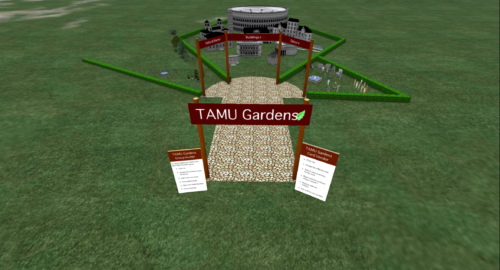
We hired an artist, Willie Irene (aka Charlotte Beimler), to make the buildings. Her first building, the Parthenon, didn’t have much detail, and, on reflection, Willie and I decided all the buildings should share this ‘sketch’ style. This would give all the gardens visual unity, and also keep the garden elements from being overshadowed by great architecture.
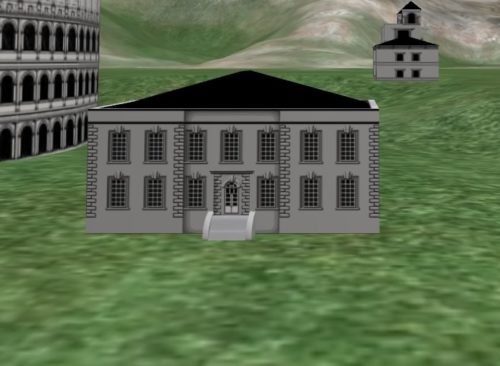
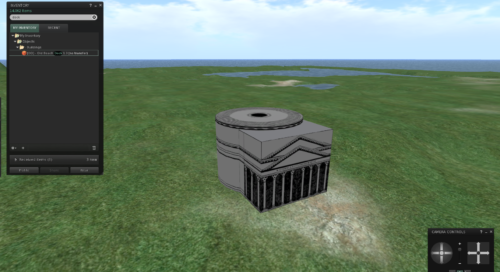
The Landscape Architecture team also wanted to incorporate buildings into the landscape. I knew from experience that dragging full-size buildings around Second Life isn’t always easy. Additionally, I didn’t have the skillset to construct a Second Life building. The prim count was also a concern. Most buildings are very high in prims, so if we used large avatar-sized buildings we would be in danger of exhausting the island’s prim balance. As a compromise, we decided to scale everything down and use tiny buildings that our avatars could not enter. This meant the buildings didn’t need to be complicated at all. Their construction would have much in common with a set of children’s building blocks.
For our pilot, Willie created about fifteen buildings. She also created parterres, some topiaries, and several textures students could use to create paths, flower beds, vegetable gardens, and ponds. I assigned plots of land to all students, and we waited with baited breath to see what they would create.
The pilot was the week before finals, and we hit an almost insurmountable snag right off the bat. The computer labs, where most of the students planned to work, hadn’t updated their Second Life client in ages, so many students could not log into Second Life, let alone get to our island. Tech support did not respond quickly to my pleas for help, so the instructors developed an alternative assignment. As a result, only three students completed the exercise. Two of the resulting gardens, however, were successful!
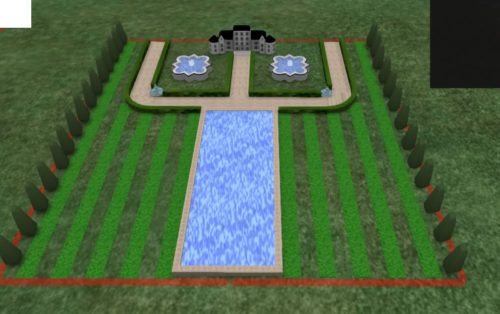
This student’s striped lawn is very typical of the Enlightenment period.
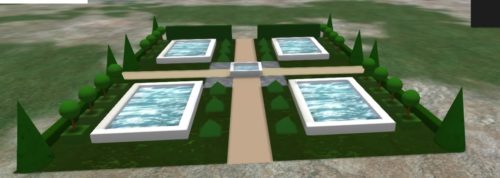
Pleased with the results, we started making plans to continue the project. The Architecture Department, however, had other plans. Linden Labs discontinued their educational pricing, so the department decided to forgo renting an island for another year. This was, of course, disheartening. The team had spent a considerable amount of time on the project, and it hurt terminating it when we were so close to success.
I’ve stored all the nursery items in my inventory, along with the debit card system. Maybe one day we’ll get to revisit this. I’ve been hearing since 2008 that Second Life is about to die, but so far it hasn’t happened. Maybe there is hope for this project, too.